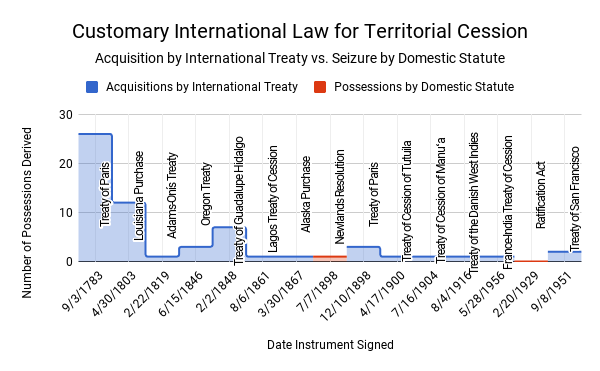Hōʻike Pōkole - Summary
- From 1783 to 1867 (84 years), the U.S. entered 6 bilateral treaties of cession for the territory of its capital and 49 states (50 possessions).
- The U.S. Constitution explicitly delegates treaty-making power jointly to the President and Senate, not both houses of Congress.
- The Treaty of Guadalupe Hidalgo in 1848 completed the territorial annexation of Texas, ratifying its statehood admission by joint resolution in 1845.
- Unlike Texas in 1845, Hawaiʻi in 1898 was not admitted as a state by the U.S. Instead, it was allegedly annexed as an unincorporated territory.
- The Newlands Resolution followed two failed attempts, in 1893 and 1897, to ratify a bilateral treaty of cession for Hawaiʻi in the U.S. Senate.
- 5 months after the Newlands Resolution in 1898, the U.S. resumed the custom of bilateral treaties of cession for territorial annexation.
- From 1898 to 1951 (53 years), the U.S. entered 5 more bilateral treaties of cession for the territory of 8 additional possessions, excluding Hawaiʻi.
- The Indian Appropriation Act (1871) and Island of Palmas arbitration (1925) required a joint resolution to ratify the treaties of cession for American Sāmoa.
- Since the cession of American Sāmoa was by chiefs rather than conventional nation-states, it wasn't eligible for an annexation treaty in the U.S. Senate.
- American Sāmoa has been on the United Nations list of non-self-governing territories since its inception in 1964.
- From 1783 to 1951 (168 years), the U.S. has entered at total of 11 bilateral treaties of cession for the territory of its 58 possessions, excluding Hawaiʻi.
- 98.3% (58 out of 59) of territorial possessions claimed by the United States were annexed with 11 bilateral treaties of cession over a period of 168 years.
- Bilateral treaties of cession between countries other than the United States occur before (Lagos to Great Britain in 1861) and after (France to India in 1956) the Newlands Resolution. in 1898
Nā Manaʻo Pani - Conclusions
- Customary international law for territorial cession is prescribed by the self-evident pattern emerging from the complete data set.
- A congressional joint resolution is a domestic statute incapable of reaching across borders to unilaterally annex a foreign country under international law.
- The enumerated constitutional power of the U.S. Congress to admit states is limited to U.S. territory acquired by annexation treaty.
- Statehood admission of Texas by joint resolution in 1845 is not a valid precedent for alleged territorial annexation of Hawaiʻi by joint resolution in 1898.
- The U.S. claim of territorial annexation of Hawaiʻi by a congressional joint resolution (unilateral declaration) is an unprecedented historical anomaly.
- The Newlands Resolution has never been followed by the U.S. or other countries as a new precedent set for territorial cession (annexation).
- Since at least 1783, a bilateral treaty of cession remains a necessary instrument for territorial annexation under customary international law.
- Crimea was unilaterally seized by Russia in 2014 without a bilateral treaty of cession.
- The annual War Report published by the Geneva Academy classifies Crimea as a state under belligerent occupation by Russia since 2014.
- The Hawaiian Kingdom government was compromised by insurgents on 7/1/1887, and remains unlawfully seized since 1/17/1893.
- The landing of United States troops in Honolulu on August 12, 1898, as a result of the Spanish-American War, violated the neutrality of the Hawaiian Kingdom by using the islands as a base of military operations.
- The continuity of the Hawaiian Kingdom as a sovereign, independent State is presumed under international law, despite ongoing unlawful seizure of its government under prolonged occupation by the United States.
Nā Kūmole - References
- Marciel, K. K. (2015, April 26). U.S. constitutional law and customary international law for territorial annexation. Hawaiian Kingdom Blog.
- Marciel, K. K. (2015, April 15). News media misses real story in reporting on TMT protest. Honolulu Civil Beat.
Ua Mau ke Ea o ka ʻĀina i ka PonoThe object of the Hawaiian Patriotic League is to affirm the continuity of Hawaiian independence, to rise as a people and defend our lands forever.
Ea mai ana ko Hawaiʻi me ke aloha mau i ka ʻāina. |
ALOHA ʻĀINA |
Hoʻopaʻakope ʻia © 2016-2019 - Ka ʻAhahui Hawaiʻi Aloha ʻĀina
